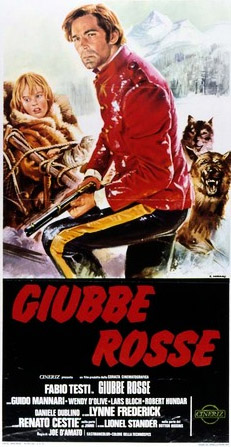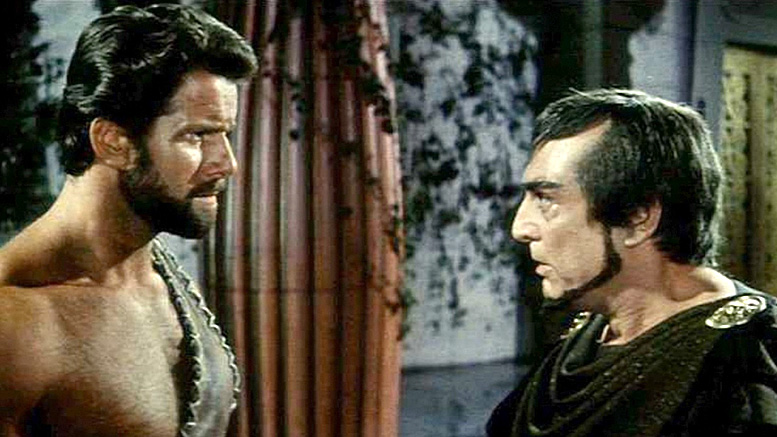Aka Giubbe rosse
1975
100 min
Italy
A Coralta peoduction
Distributed by Cineriz
Director: Aristide Massaccesi
Story: Claudio Bernabei, Aristide Massaccesi
Screenplay: Claudio Bernabei, Aristide Massaccesi
Cinematography: Aristide Massaccesi
Music: Carlo Rustichelli
Editor: Bruno Miheli
Cast: Fabio Testi (Corporal Bill Cormack), Guido Mannari (Cariboo), Lynne Frederick (Elizabeth, Bill’s wife), Renato Cestiè (Jimmy), Lionel Stander (Doctor Higgins), Wendy D’Olive (Shee-Noa), Robert Hundar [Claudio Undari] (Wolf), Lars Bloch (Andy), Daniele Dublino (the lieutenant), Geoffrey Coppleston (RCMP chief), Bruno Corazzari (Logan), Paolo Magalotti (Carter, a trapper), Luigi Antonio Guerra (Wolf’s man), Aldo Cecconi, Emilio Messina (Logan’s man), Lucio Montanaro (uncredited, according to imdb), Renzo Pevarello (McRea, Wolf’s man, uncredited, according to IMDB)
Red Coat is a rather peripheral entry into the White Fang series of films. It has all the key elements of the genre – snowy, mountainous settings, big men in fur coats, copious sledge riding, imperilled child protagonist – except one: it doesn’t feature a dog. Or, rather, it does feature a dog, but the mutt in question is so insignificant to the plot that it could just as well not feature at all. In effect, it gets shot in the leg, sits around in a log cabin recovering and finally emerges at the very climax to gnaw on a villain or two; hardly the most active of canine characters.
The film also boasts a rather peculiar structure, starting off with a lengthy flashback, lasting a good 20 minutes, which sets up the background story for the main narrative. Bill Cormack (Fabio Testi), who is just starting out in his career as a Mountie, bumps into his old childhood friend, Caribou (Guido Mannari), now a professional card-shark who is in a relationship with a beautiful young singer called Elizabeth (Lynne Frederick). Unfortunately, Caribou sinks further into a life of crime and, after escaping arrest – and wounding Bill in the act – he becomes a fully fledged outlaw, bringing together one of the most feared gangs in the whole of Canada. Bill and Elizabeth, meanwhile, grow closer, eventually marrying and having a son, Jimmy (Renato Cestiè).
Back in the present day, Caribou manages to escape from prison and, determined to have his revenge, kidnaps poor little Jimmy, now a young boy. Understandably disconsolate, Bill – who’s now become such an accomplished lawman that he’s known as ‘the hunter’ – immediately sets off with his partner, Andy (Lars Bloch), to track them down, and before long they’ve been led into the inhospitable mountains, where every step is fraught with danger etc etc. Making things worse, a bunch of Caribou’s former criminal associates are also on his tail, hoping to lay their hands on all the gold he managed to stash before being sent to prison, and they don’t exactly have any love for Cormack either.

In all, Red Coat stands as being a rather atypical production. It was undoubtedly made in the wake of Call of the Wild and White Fang, and it’s arguably truer to the genres origins and the books of Jack London than several of the other films under discussion, even if they do feature a more prominent pooch. But the story is more along traditional Spaghetti Western lines, familiar from films such as Vengeance or, more particularly, For $100,000 per Killing; a kind of revenge / manhunt thriller with elements of familial melodrama. And, as such, it’s all far more interesting than perhaps could have been expected, managing to avoid a number of the habitual genre pitfalls: too many fist-fights, a sense of cloying sentimentality, too much emphasis on half-baked comedy.
The script, which is credited to director Aristide Massaccesi (using his normal Joe D’Amato moniker) and Claudio Bernabei (also often mistaken for another Massaccesi pseudonym), is far better than usual, throwing in a number of unexpected twists and turns and even displaying some proper attempts at character development. Actor George Eastman has claimed that he was the actual writer, and this does seem to have some credence, as it has certain elements in common with his script for the later, better known Keoma (76), not to mention the fact that it’s far better than the kind of material Massaccesi and Bernabei usually worked with.
But D’Amato too, appears to have been energised. He was a filmmaker who knew how to direct, but more often than not simply seemed not to bother. Here, though, he does a decent job, and with his cinematographer’s eye he brings a keen visual sense to it all, ensuring that the snowy, widescreen vistas look absolutely spectacular. It’s certainly a lot better than his other Spaghetti Western, A Bounty Hunter in Trinity, and streets ahead of just about anything he made after 1980. He even manages to throw in an action packed climax that’s almost worthy of Enzo Castellari; a very different kind of action to the type he went on to become famous for shooting later in his career.
It’s kind of hard to work out quite what was going on with Fabio Testi’s career at this time. After starting out as a stuntman, he’d made his name in a couple of high profile releases in the early seventies (Il giardino dei Finzi-Contini (70), Addio, fratello crudele (71)), but he still seemed happy appearing in comparatively small-scale westerns such as this and Dieci bianchi uccisi da un piccolo indiano (74). He does a pretty good job, bringing a certain intensity to his character, and he’s ably supported by Guido Mannari, who later had a big role in Caligula (79). Lynne Frederick, who popped up in a few European productions at the time (she starred again with Fabio Testi in The Four of the Apocalypse (75)), is very attractive, but disappears rather inexplicably after the first half hour.
